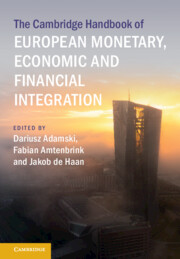Book contents
- The Cambridge Handbook of European Monetary, Economic and Financial Integration
- The Cambridge Handbook of European Monetary, Economic and Financial Integration
- Copyright page
- Contents
- Contributors
- Introduction
- Part I The Economic and Monetary Union
- 1 Conceptual Foundations of Economic and Monetary Union
- 2 Theorizing Economic and Monetary Union
- 3 Monetary Union and the Single Currency
- 4 On the Misalignment of Monetary, Economic, and Political Integration in European Economic and Monetary Union
- 5 Ideas, Interests, and Power
- 6 Coping with Economic Crises through Learning by Doing
- 7 The Political Economy of Reinsurance
- 8 Euro Crises, the Productivity Slowdown, and the EMU
- Part II The Monetary Dimension
- Part III The Economic and Fiscal Dimensions
- Part IV Financial Integration
- Index
- References
3 - Monetary Union and the Single Currency
from Part I - The Economic and Monetary Union
Published online by Cambridge University Press: 28 September 2023
- The Cambridge Handbook of European Monetary, Economic and Financial Integration
- The Cambridge Handbook of European Monetary, Economic and Financial Integration
- Copyright page
- Contents
- Contributors
- Introduction
- Part I The Economic and Monetary Union
- 1 Conceptual Foundations of Economic and Monetary Union
- 2 Theorizing Economic and Monetary Union
- 3 Monetary Union and the Single Currency
- 4 On the Misalignment of Monetary, Economic, and Political Integration in European Economic and Monetary Union
- 5 Ideas, Interests, and Power
- 6 Coping with Economic Crises through Learning by Doing
- 7 The Political Economy of Reinsurance
- 8 Euro Crises, the Productivity Slowdown, and the EMU
- Part II The Monetary Dimension
- Part III The Economic and Fiscal Dimensions
- Part IV Financial Integration
- Index
- References
Summary
This chapter examines the origins of European Monetary Union in a debate that started in the 1960s about the dangers posed by German current account surpluses. Solving the question of the German current account in the European setting at first appeared to require some sophisticated and ingenious political mechanism that would force French politicians to pursue more austerity than they would have liked, and Germans less price orthodoxy than they thought they needed. A political mechanism, however, requires continual negotiation and public deliberation, which would have been painful given the policy preferences in the two countries (and in those countries that lined up with either of the Big Two). The increased attraction of monetary union was that it required no such drawn-out political process. The operation of an entirely automatic device would constrain political debate, initiative, and policy choice. But this process raised two questions that were not adequately solved in the sober and meticulous arguments for monetary union, and the monetary union was thus left incomplete. The first concerned the fiscal discipline needed for currency union; the second and even more serious related to the need for a central bank to exercise general financial sector supervision and regulation.
- Type
- Chapter
- Information
- Publisher: Cambridge University PressPrint publication year: 2023



